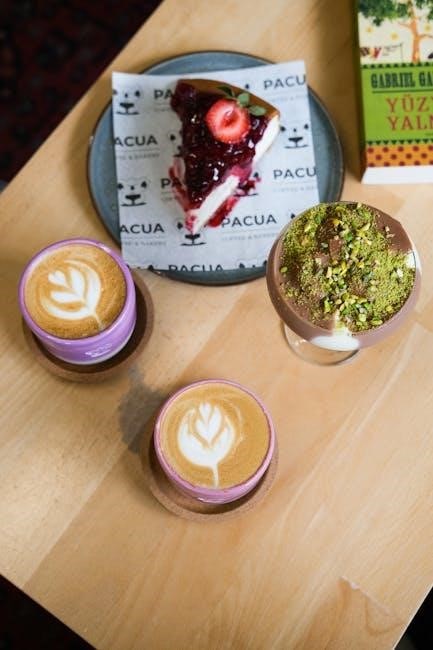
This compelling book by Marc Aronson and Marina Budhos explores sugar’s profound impact on global history, culture, and economies, tracing its journey from ancient origins to modern times.
Overview of the Book’s Theme and Significance
Sugar Changed the World delves into the transformative power of sugar, tracing its journey from ancient origins to its global dominance. The book reveals how sugar shaped economies, cultures, and societies, intertwining with slavery, colonialism, and innovation. By exploring sugar’s role in history, the authors highlight its profound impact on global trade, politics, and social structures. This compelling narrative connects personal stories with broader historical events, offering a unique perspective on how sugar influenced the world’s development. The book’s significance lies in its ability to illuminate the intricate connections between food, power, and human history, making it a vital read for understanding the complexities of our interconnected world.
Authors’ Perspectives: Marc Aronson and Marina Budhos
Marc Aronson and Marina Budhos bring unique perspectives to Sugar Changed the World, blending historical insight with storytelling. Aronson, a historian and award-winning author, offers a deep understanding of global trade and its societal impacts. Budhos, with her literary expertise, crafts compelling narratives that engage readers of all ages. Together, they reveal how sugar’s history intertwines with themes of power, slavery, and cultural exchange. Their collaboration creates a rich, accessible exploration of sugar’s role in shaping the modern world, making the book both educational and engaging for young adults and educators alike.
The Book’s Target Audience and Educational Value
Sugar Changed the World is primarily aimed at young adults and educators, offering an engaging exploration of history, culture, and economics. Written in an accessible and entertaining style, it is particularly suitable for students in grades eight and above. The book’s interdisciplinary approach makes it a valuable resource for classrooms, connecting themes of trade, slavery, and cultural transformation. By tracing sugar’s global impact, it encourages critical thinking about how historical events shape the modern world. Its educational value lies in its ability to make complex topics relatable, fostering a deeper understanding of the interconnectedness of human societies and the legacies of colonialism. This makes it an ideal tool for sparking discussions about history, ethics, and the consequences of consumer choices.

The Historical Origins of Sugar
Sugar’s journey began in New Guinea around 7000 BC, evolving from a local crop to a global commodity through ancient trade routes and cultural exchange.
Sugar’s Early History: From New Guinea to Ancient Trade Routes
Sugar’s origins trace back to New Guinea around 7000 BC, where it was first cultivated from sugarcane. Early societies valued it for its sweetness and medicinal properties. As trade expanded, sugar spread along ancient routes, becoming a prized commodity in the Middle East, India, and China. Its cultivation and trade played a significant role in shaping early economies and cultural exchanges. By 500 BC, sugar had reached Persia, where it was refined further. This early history laid the foundation for sugar’s global influence, marking it as a transformative force in human history and development.
The Role of Sugar in Ancient Civilizations
Sugar played a significant role in ancient civilizations, initially valued for its medicinal and ritualistic uses. In ancient India, sugarcane was cultivated and refined into crystals, becoming a luxury item. By 500 BC, sugar had spread to the Middle East, where it was used in cooking and medicine. The Greeks and Romans later adopted it, though it remained rare and expensive. Sugar’s influence extended beyond cuisine, shaping trade networks and cultural practices. Its scarcity made it a symbol of wealth, while its versatility in preserving foods and creating sweets solidified its importance. This early reliance on sugar laid the groundwork for its enduring impact on global societies.
The Spread of Sugar Through Global Exploration and Colonization
The spread of sugar accelerated during global exploration and colonization, as European powers sought new resources. Columbus introduced sugarcane to the Americas, and by the 16th century, sugar plantations flourished in the Caribbean and Brazil. Colonization enabled the mass production of sugar, driven by enslaved labor from Africa. This system, often called the “sugar machine,” reshaped economies and societies worldwide. Sugar became a commodity fueling global trade, connecting Europe, Africa, and the Americas. Its production enriched colonial powers but devastated indigenous populations and enslaved workers, leaving a legacy of exploitation that shaped modern global dynamics. Sugar’s journey from luxury to staple underscored its transformative power.
Sugar and the Rise of Slavery
Sugar’s rapid growth as a commodity fueled the rise of slavery, as enslaved labor became central to plantation economies, reshaping global trade and societal structures irreparably.
The Connection Between Sugar Plantations and the Slave Trade
The rise of sugar plantations in the Americas created a massive demand for labor, directly fueling the transatlantic slave trade. Enslaved Africans were forcibly brought to work under brutal conditions on sugar estates, which became a cornerstone of colonial economies. The profitability of sugar relied on cheap, coerced labor, making the slave trade indispensable to the industry. This system not only perpetuated extreme suffering but also shaped global power dynamics, as European powers competed for control of sugar-producing regions. The book highlights how sugar plantations and slavery were deeply intertwined, forming a foundation for modern economic and social inequalities.
The Impact of Sugar Production on Enslaved Communities
Sugar production had a devastating impact on enslaved communities, forcing them into relentless labor under inhumane conditions. The demanding nature of sugar cultivation led to physical exhaustion, malnutrition, and high mortality rates. Enslaved individuals were subjected to brutal punishments and separated from their families, eroding cultural identities. The trauma of slavery reverberated across generations, leaving lasting scars on communities. Sugar plantations relied on this coerced labor, perpetuating a system of exploitation that fueled economic growth for colonizers while destroying the lives of the enslaved; The book sheds light on how sugar production deepened racial inequalities and shaped the social fabric of the Americas.
How Sugar Shaped the Economy of the Americas
Sugar became the backbone of the economies in the Americas, driving wealth and growth for colonial powers. Plantations dominated landscapes, transforming vast areas into productive hubs reliant on enslaved labor. The sugar trade established lucrative markets, fostering global commerce and enriching European nations. It financed infrastructural development, spurred urban growth, and influenced trade policies. However, this prosperity came at a steep cost, perpetuating inequality and exploitation. Sugar’s economic dominance reshaped financial systems, creating cycles of dependency that lingered long after colonial rule ended. Its impact on the Americas’ economies remains a testament to the duality of progress and exploitation in global history.
Sugar’s Influence on Global Politics and Economy
Sugar reshaped global trade, fueled economic growth, and influenced political power, becoming a commodity that drove empires’ rise and shaped international relations and economies profoundly.
Sugar as a Commodity in Colonial Empires
Sugar became a cornerstone of colonial economies, driving the expansion of empires and shaping global trade. European powers like Britain, France, and the Netherlands established vast sugar plantations in colonies, relying on enslaved labor to meet skyrocketing demand. The commodity’s profitability fueled colonial competition, as controlling sugar-producing regions became a geopolitical priority. Sugar’s value also influenced colonial policies, with empires often prioritizing territories that could support its production. This system of exploitation not only enriched colonial powers but also deeply intertwined sugar with the transatlantic slave trade, forging a legacy of inequality and oppression that shaped the modern world.
The Role of Sugar in Shaping International Trade Relations
Sugar played a pivotal role in shaping international trade relations, driving exploration and colonization. European powers sought new trade routes to secure sugar supplies, fueling voyages of discovery. The commodity’s high demand led to the establishment of triangular trade routes, connecting Europe, Africa, and the Americas. Sugar production relied on enslaved labor, creating a lucrative yet exploitative system. This trade not only enriched European economies but also forged complex political alliances and rivalries. The dominance of sugar in global markets influenced treaties, wars, and economic hierarchies, leaving a lasting legacy in the structure of modern international trade and global power dynamics.
How Sugar Influenced the Rise and Fall of Empires
Sugar significantly influenced the rise and fall of empires, shaping their economic and political trajectories. European powers like Portugal, Spain, and Britain built vast empires partly due to sugar’s profitability. The wealth generated from sugar plantations and trade enabled these empires to expand and dominate global markets. However, reliance on sugar also led to vulnerabilities, as conflicts over colonies and resources escalated. The decline of sugar’s profitability and shifts in global demand contributed to the fall of these empires, illustrating how a single commodity could both empower and destabilize imperial powers. Sugar’s legacy remains intertwined with the ebb and flow of imperial histories.

Sugar and Cultural Transformations
Sugar reshaped global cuisine, rituals, and social hierarchies, becoming a symbol of wealth and celebration. Its widespread use transformed diets and cultural practices, leaving a lasting legacy.
Sugar’s Role in Shaping Global Cuisine
Sugar revolutionized global cuisine by introducing new flavors and preservation techniques. It enabled the creation of candies, desserts, and sweetened beverages, blending culinary traditions across cultures. From tropical fruits to spices, sugar enhanced flavors, making it a staple in kitchens worldwide. Its influence is evident in dishes like pastries, cakes, and syrups, which became central to celebrations and daily meals. The integration of sugar into recipes fostered cultural exchange, as trade routes brought exotic ingredients together. This sweetener’s versatility transformed cooking, creating a shared culinary language that continues to evolve and unite people across the globe.
The Social and Cultural Significance of Sugar in Different Societies
Sugar holds profound cultural and social significance across various societies, often symbolizing wealth, status, and celebration. In many cultures, sugar is integral to rituals and ceremonies, such as weddings and religious events, reflecting its value. The luxury of sugar shaped social hierarchies, as its rarity made it accessible only to the elite. Over time, its widespread availability democratized access, influencing culinary traditions and cultural exchange. Sugar’s role in shaping identities and fostering global connections underscores its enduring impact on societal norms and traditions, making it a cornerstone of cultural heritage and shared human experiences worldwide.
How Sugar Became a Symbol of Wealth and Status
Sugar’s rarity and high cost transformed it into a symbol of wealth and status, particularly in Europe during the Middle Ages. Only the elite could afford this luxury, using it to display their opulence. Sugar adorned banquet tables, ornate sculptures, and exclusive dishes, signifying power and refinement. Its scarcity made it a prized commodity, often gifted among nobility and used in lavish feasts. As trade expanded, sugar’s availability grew, but its association with wealth persisted, embedding it in cultural and social practices as a marker of prestige and privilege. This status symbol shaped societal norms and culinary traditions for centuries.

Sugar, Science, and Technology
Sugar’s transformation through scientific breakthroughs and technological innovations revolutionized production, refining, and accessibility, driving industrial and culinary advancements while shaping medical and food science applications globally.
The Scientific Discoveries That Shaped Sugar Production
The history of sugar production is deeply intertwined with groundbreaking scientific discoveries. Early innovations, such as the development of sugar presses and crystallization techniques, revolutionized how sugar was extracted and refined. The invention of the centrifugal machine in the 19th century further enhanced efficiency, allowing for mass production. Additionally, the understanding of sugarcane genetics led to hybrid varieties that were more disease-resistant and productive. Key figures like Norbert Rillieux pioneered advancements in sugar processing, creating technologies that transformed the industry. These scientific breakthroughs not only streamlined production but also made sugar more accessible, shaping its role in global trade, cuisine, and medicine, as highlighted in “Sugar Changed the World.”
Technological Advancements in Sugar Refining and Processing
Technological innovations transformed sugar refining and processing, making it more efficient and scalable. The introduction of the centrifugal machine in the 19th century revolutionized sugar extraction, enabling faster and cleaner separation of sugar crystals from molasses. Later, the development of vacuum pan technology improved sugar crystallization, reducing impurities and energy consumption. Modern advancements, such as automated processing systems and advanced filtration methods, have further streamlined production. These technologies not only increased yield but also enhanced the quality of refined sugar, making it a staple in global markets. As detailed in “Sugar Changed the World,” these innovations played a crucial role in shaping the sugar industry’s growth and accessibility.
How Sugar Influenced Medical and Culinary Innovations
Sugar’s influence extended beyond cuisine, shaping medical and culinary advancements. In medicine, sugar was used to preserve remedies and mask bitter flavors, aiding in the creation of early pharmaceuticals. Culinary innovations flourished as sugar enabled the development of baked goods, candies, and desserts, transforming global cuisine. Its preservative qualities allowed for food storage, revolutionizing culinary practices. The book highlights how sugar’s versatility spurred creativity in both fields, leading to enduring culinary traditions and medical applications. This dual impact underscores sugar’s profound role in shaping human health and culinary culture, as explored in “Sugar Changed the World.”

The Dark Side of Sugar: Health and Ethical Concerns
Sugar’s detrimental health impacts, such as diabetes and obesity, are coupled with ethical dilemmas in production, highlighting the dark side of this seemingly sweet commodity.
The Health Impact of Sugar Consumption Throughout History
Sugar consumption has left a lasting mark on global health, from ancient times when it was a rare luxury to its modern ubiquity. Early societies experienced limited health issues due to its scarcity, but as sugar became widespread, diets rich in refined sugars led to tooth decay, obesity, and other ailments. The rise of sugar plantations and industrial production made it accessible to the masses, contributing to chronic diseases like diabetes and heart conditions. Historical records show how sugar’s overconsumption correlates with declining health trends, highlighting its dual role as a delightful indulgence and a silent culprit in global health crises.
Ethical Issues Surrounding Sugar Production and Trade
The production and trade of sugar have been deeply intertwined with ethical dilemmas throughout history. From the brutal exploitation of enslaved labor in plantations to modern-day issues of child labor and unfair wages, the sugar industry has often prioritized profit over human rights. The book highlights how sugar’s sweetness was bitterly contrasted with the suffering of those forced to cultivate it, particularly during the transatlantic slave trade. Additionally, environmental degradation caused by large-scale sugar farming raises concerns about sustainability. These ethical complexities underscore the need for greater accountability in the industry and more equitable practices to address the legacy of exploitation tied to sugar production.
Modern-Day Debates About Sugar’s Role in Society
Today, sugar remains a focal point of intense debate, with discussions centered on its health impacts, ethical production, and environmental consequences. The book sheds light on how modern society grapples with sugar’s ubiquity in processed foods, contributing to health crises like obesity and diabetes. Advocates call for stricter regulations and clearer labeling, while the industry defends its practices. Additionally, sustainable farming practices and fair trade initiatives are gaining attention, aiming to address historical injustices and environmental harm. These debates highlight the complex interplay between sugar’s cultural significance, economic power, and its effects on global health and ecosystems, urging a reevaluation of its role in our lives.
The book offers a transformative perspective on sugar’s role in shaping global history, culture, and economies, leaving readers with a deeper understanding of its enduring impact.
The Book’s Contribution to Understanding Global History
Sugar Changed the World provides a compelling narrative that connects sugar to global events, economies, and cultures. By tracing sugar’s journey from ancient origins to modern times, the book reveals how this commodity shaped empires, influenced slavery, and transformed societies. Its accessible style makes complex historical connections understandable, offering educators and students a valuable resource. The authors’ unique perspectives, blending personal and global insights, highlight sugar’s enduring legacy in shaping the world we live in today. This book is not just about sugar—it’s about how one substance has influenced human history in profound and unexpected ways.
How the Book Inspires Reflection on Modern Sugar Consumption
Sugar Changed the World encourages readers to reflect on the modern implications of sugar in their diets and lives. By connecting historical patterns of production and consumption to contemporary issues, the book prompts critical thinking about the ethical, environmental, and health impacts of sugar. The authors’ vivid storytelling and accessible style make it easy for young readers to draw parallels between the past and present. This reflection inspires a deeper understanding of the choices we make today, fostering a more informed approach to sugar consumption and its broader societal effects.
The Lasting Impact of Sugar on the World Today
Sugar’s influence persists globally, shaping economies, cultures, and health. Its role in modern industries, from food production to biofuels, underscores its enduring significance. The book highlights how sugar’s historical ties to slavery and colonization have left lasting social and economic imprints. Today, sugar remains a commodity of power, affecting trade relations and public health. Its impact is evident in rising health concerns, environmental degradation, and ongoing debates about ethical production. Sugar Changed the World challenges readers to consider how sugar’s past continues to mold its present and future, making it a vital topic for understanding contemporary global dynamics.